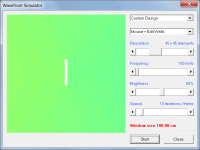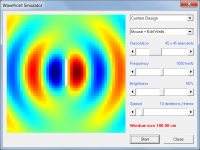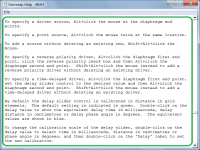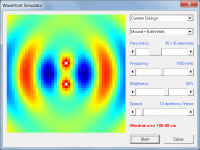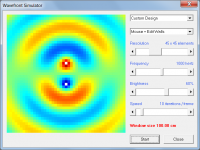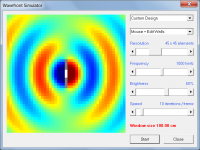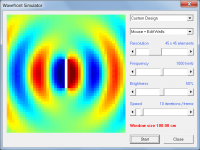Hi,
Sadly you disagree with the fundamental fact front and
rear radiation of a driver is out of phase. Any attempt
to justify your position is just illustrating ignorance.
rgds, sreten.
According to your facts air dosnt move so forgive me if I'm not buying your "facts".
Prove it in the near field.
So if I put sub drivers without boxes next to each other and then turn one around I will get the same spl?
So when a speaker moves the air right in front of it dosnt move? So the air goes thru the driver?
At low frequencies the driver is far smaller than a wavelength and the air takes the path of least resistance from compression in front and rarefaction behind around the outside edges of the driver with less radiated SPL.
More than you want to know...
http://robots.mit.edu/publications/papers/1997_01_Opp_Dub.pdf
Right, it is.Hi Y'all,
It looks to me that the diagram in Post #8 is for a monopole, not the dipole radiation of a freely suspended radiator?
Regards,
I was just trying to find a relevant picture to show in general terms how high frequency beaming works to explain the baffle roll-off at low frequency. It illustrates how HF is projected forward while LF wraps around the sound source with varying degrees of directivity in between. Extrapolating how that affects cancellation for a driver suspended in air is an exercise left for the reader, you could say.
Last edited:
The way sound radiates is very dependent on how large the sound source is vs. how large the wavelength is of the sound. Even with a very large driver like an 18" woofer, a 50hz wave is 6.8m and therefore much larger. The sound then radiates omnidirectionaly from the cone and the front and rear cancel each other to a very significant degree.
As illustrated in Attachment 1 (frequency = 100Hz).
At 1500hz, however, the wavelength is .23m. The 18" woofer's diameter is now twice the wavelength of the sound. The wave now propagates much more forward and backward and much less to the sides. Since the front and rear are interacting much less now, you get far less cancellation.
As illustrated in Attachment 2 (frequency = 1000Hz).
Attachments
Last edited:
Hi Ron, if i am not wrong the interference notches in the frequency response of loudspeaker in free air is due to dipole effect and in baffle radiating in 2 pi steridian the interference notches in the frequency response is due to baffle effect and the room?
Hi David i just installed HornResp it looks very clever software, I was playing with the wavefront simulator, how do i add more monopole source with mouse click?As illustrated in Attachment 1 (frequency = 100Hz).
As illustrated in Attachment 2 (frequency = 1000Hz).
According to your facts air dosnt move so forgive me if I'm not buying your "facts".
Prove it in the near field.
So if I put sub drivers without boxes next to each other and then turn one around I will get the same spl?
Hi,
Of course air moves for pressure, but has no translation except at DC.
FWIW for your question the answer is no you won't, but you don't know why.
Seriously its a totally inept question, as you don't understand the basics.
rgds, sreten.
Looks like a lot of people are struggling to think in two dimensions let alone, as is needed, in four dimensions and statistically.
Yes. when 180 degrees out of phase, there is cancellation. But in a room with a normal reverberation, with the source (a speaker or even a raw driver) in that room, just what places have this cancellation? Are there almost as many places where the front and back waves add? Not to mention music.
Anybody out there actually measured phase relationship? Even for two subs, often hard to figure out when they are in phase unless luckily situated in perfectly symmetrical locations to the mic. With Toole, Geddes, or Welti sub locations, often hard to figure which phasing is better since the bumps and dips will favour either phase of two speakers differently and three or four... tricky.
Measuring two upper freq speakers, there are places where they add together just swell and there are frequencies where they interfere. Move the mic and inch, and those frequencies change.
No one disputes the simple model in textbooks and sims. But in the real world, more complicated.
Ben
Yes. when 180 degrees out of phase, there is cancellation. But in a room with a normal reverberation, with the source (a speaker or even a raw driver) in that room, just what places have this cancellation? Are there almost as many places where the front and back waves add? Not to mention music.
Anybody out there actually measured phase relationship? Even for two subs, often hard to figure out when they are in phase unless luckily situated in perfectly symmetrical locations to the mic. With Toole, Geddes, or Welti sub locations, often hard to figure which phasing is better since the bumps and dips will favour either phase of two speakers differently and three or four... tricky.
Measuring two upper freq speakers, there are places where they add together just swell and there are frequencies where they interfere. Move the mic and inch, and those frequencies change.
No one disputes the simple model in textbooks and sims. But in the real world, more complicated.
Ben
Last edited:
No one disputes the simple model in textbooks and sims.
But in the real world, more complicated.
Ben
Hi,
Someone disagreeing with fundamental facts is just wrong. And
here we have someone disputing that the simple model as wrong.
rgds, sreten.
Looks like a lot of people are struggling to think in two dimensions let alone, as is needed, in four dimensions and statistically.
...
No one disputes the simple model in textbooks and sims. But in the real world, more complicated.
Ben
What are you talking about? You dispute textbooks and sims all the time and you are doing it here too.
The simple fact is that a dipole will have a dipole (figure 8) dispersion pattern regardless of whether you place it in an open field or in a small room. This pattern causes losses (cancellation) and these losses happen long before the effects of the room get involved. These losses mean that a dipole is always going to put less total energy into the room than a monopole. There's your dimensions and statistics.
YES the room does change things several milliseconds after the dipole gets done performing it's function and providing the textbook figure 8 dispersion pattern including the associated losses. But you can't plausibly argue that since the room changes stuff AFTER the textbook dispersion pattern happens that the textbook dispersion pattern is not valid.
You are trying to lump the speaker's response and the room's response in together and argue that that the summed response means the textbook speaker response is not valid. This is not true. It comes from a place of misunderstanding and a fundamental lack of knowledge.
Hi Ron, if i am not wrong the interference notches in the frequency response of loudspeaker in free air is due to dipole effect and in baffle radiating in 2 pi steridian the interference notches in the frequency response is due to baffle effect and the room?
I am not sure I understand the question. A 3" loudspeaker on a 12" diameter baffle will have similar "doublet" cancellation dips as a 12" driver without a baffle...
Hi,
Someone disagreeing with fundamental facts is just wrong. And
here we have someone disputing that the simple model as wrong.
rgds, sreten.
The words "No one disputes the simple model in textbooks and sims" means that the writer (me) also does NOT dispute the simple model.
In case you didn't get that, let me add, I do not dispute the simple model.
But the stochastic and complicated situation in a room would make Blumlein faint. As anybody with a mic and REW can attest.
Have you read Toole's great book?
B.
Last edited:
Don't try to backpeddle. The room has nothing to do with anything in this thread called "Radiation of loudspeaker in free air".
You brought the room into this to arrogantly proclaim "Looks like a lot of people are struggling to think in two dimensions let alone, as is needed, in four dimensions and statistically.
Which is in itself an addition to the weird notions that you posted in post 9 in which you stated "Some folks see a textbook illustration of phase cancellation and believe it applies to their room.", as well as a few other nuggets of nonsense.
The phase cancellation happens at the baffle edges, long before the rest of the room gets involved. You continue to confuse the summed response of the speaker and the room effects with the phase cancellation happening in close proximity (at the baffle edge) of the speaker itself.
This isn't complicated. The speaker does it's thing and then the room provides reflections. In the case of OB there's no room pressurization (room gain) because there's no net difference in displacement in the room's air on the front and back stroke, so it's just reflections and modes.
You want to make it seem like the room makes everything an overcomplicated mess and this quote specifically says you believe the room effects invalidate the phase cancellations of dipoles at least to some degree "Here people believe that when matter and anti-matter meet at the black-hole horizon, they totally annihilate one another, or something like that... In reality, the stuff the coming out the back heads off in all directions and bounces back in ways that are not feasible to predict", and that it's impossible to even guess what type of response you might get. You continue to confuse the effects of the room with the dipoles phase cancellation, they are two different things that happen at different times.
Dipole or monopole, the room changes the response, that much is clear and in this discussion not worth mentioning, as it has nothing to do with the topic at hand. The topic at hand is that dipoles and monopoles have different radiation patterns, we know what those patterns are, it's easy to predict the response of dipole and monopole speakers (including the effect of first reflections).
And finally, what on earth does Toole's book have to do with anything? If you had actually read it and understood it a lot of these misconceptions would be cleared up, not to mention you would have sold a lot of your "hifi" gear as Toole would not speak kindly of many of the items you use and/or the way you use them.
You brought the room into this to arrogantly proclaim "Looks like a lot of people are struggling to think in two dimensions let alone, as is needed, in four dimensions and statistically.
Which is in itself an addition to the weird notions that you posted in post 9 in which you stated "Some folks see a textbook illustration of phase cancellation and believe it applies to their room.", as well as a few other nuggets of nonsense.
The phase cancellation happens at the baffle edges, long before the rest of the room gets involved. You continue to confuse the summed response of the speaker and the room effects with the phase cancellation happening in close proximity (at the baffle edge) of the speaker itself.
This isn't complicated. The speaker does it's thing and then the room provides reflections. In the case of OB there's no room pressurization (room gain) because there's no net difference in displacement in the room's air on the front and back stroke, so it's just reflections and modes.
You want to make it seem like the room makes everything an overcomplicated mess and this quote specifically says you believe the room effects invalidate the phase cancellations of dipoles at least to some degree "Here people believe that when matter and anti-matter meet at the black-hole horizon, they totally annihilate one another, or something like that... In reality, the stuff the coming out the back heads off in all directions and bounces back in ways that are not feasible to predict", and that it's impossible to even guess what type of response you might get. You continue to confuse the effects of the room with the dipoles phase cancellation, they are two different things that happen at different times.
Dipole or monopole, the room changes the response, that much is clear and in this discussion not worth mentioning, as it has nothing to do with the topic at hand. The topic at hand is that dipoles and monopoles have different radiation patterns, we know what those patterns are, it's easy to predict the response of dipole and monopole speakers (including the effect of first reflections).
And finally, what on earth does Toole's book have to do with anything? If you had actually read it and understood it a lot of these misconceptions would be cleared up, not to mention you would have sold a lot of your "hifi" gear as Toole would not speak kindly of many of the items you use and/or the way you use them.
Last edited:
Hi David i just installed HornResp it looks very clever software, I was playing with the wavefront simulator, how do i add more monopole source with mouse click?
Hi shank1207,
To add a point source without deleting an existing one, Shift+Alt+Click the mouse twice at the same location.
Attachment 1 shows the relevant section of the Help file.
Attachment 2 shows two monopole sources - with the same polarity.
Attachment 3 shows two monopole sources - one with reversed polarity.
Note that it is also possible to create phased arrays using multiple time-delayed sources.
Kind regards,
David
Attachments
A 3" loudspeaker on a 12" diameter baffle will have similar "doublet" cancellation dips as a 12" driver without a baffle...
Attachments
I'm impressed! I didn't realize such functionality existed in hornresp.
All functionality available in Hornresp is documented in the Help file - it's just that few people seem to get around to reading it 🙂.
Having a hard copy of the Help file handy while using the program, is recommended. Sections of particular interest can be highlighted with a marker pen for easy reference.
I am not sure I understand the question. A 3" loudspeaker on a 12" diameter baffle will have similar "doublet" cancellation dips as a 12" driver without a baffle...
yes this was exactly my question , so the doublet cancellation on the 12" Dirver is due to dipole behavior and for the 3" Driver is due to baffle effect?
Hi shank1207,
To add a point source without deleting an existing one, Shift+Alt+Click the delayed sources.
Kind regards,
David
Thats cool. Thanks but when i am doing the reverse polarity it turns into pink the source and i cant run start
Last edited:
David McBean's handsome pair of pictures gotta be wrong, even when played in the park hanging from a string off the ground, as others who post here seem to like.
A small driver on a 12-inch circular board (talk about unrealistic theoretical models even for people who design for music in parks!) is being compared to the output of a 12-inch diaphragm (assuming a lot of the cone is vibrating, not just the whizzer cone). I don't think a mic at a meter away would say the frequency response is the same because the sources are pretty different shapes and the interference regime very different.
I sure wish somebody would do some testing instead of this boring jaw-jaw.
Pity the folks in the sub forum aren't typically fond of the luscious sound of dipoles - in rooms, if not in parks. Um, they just don't model well....in rooms.
B.
Last edited:
- Status
- Not open for further replies.
- Home
- Loudspeakers
- Subwoofers
- Radiation of loudspeaker in free air?
